Corn snakes are some of the best pet snakes in the world. They are docile, don’t mind being handled, and come in a variety of truly beautiful colors. In fact, corn snake colorations (usually referred to as morphs) are so varied and prized that hobbyists and breeders have dedicated their lives to acquiring and breeding these snakes into over 800 recognized morphs.
For the potential pet buyer, this essentially means that there is a nearly unlimited selection of colors and patterns to choose from when picking out a corn snake. In order to help you, we have developed a list of the most notable and beautiful corn snake morphs that we could find. This list should help you pick out a corn snake morph and give you some of the history behind it. Let’s get started!
Understanding Corn Snake Breeding and Genetics
Like most things in nature, genetics don’t work like legos, and as a result, corn snake breeding has a lot of variances. Still, there are some easy ways to understand how corn snake morphs occur and how to pick the right one out for us.
Although there are over 800 corn snake morphs, there are only 5 wild-type genetic strains and 28 selected genetic strains. Most of the 800 morphs can be made from combining these 33 genetic strains into “double traits,” “triple traits,” all the way up to “five traits.” Today, we will cover some of the most popular morphs, plus look into some of the more rare and beautiful ones.
| Morph | Type |
|---|---|
| Alabama | Wild-type |
| Keys | Wild-type |
| Miami | Wild-type |
| Normal | Wild-type |
| Okeetee | Wild-type |
| Amelanistic | Single Recessive |
| Anerythristic | Single Recessive |
| Caramel | Single Recessive |
| Charcoal | Single Recessive |
| Christmas | Single Recessive |
| Cinder | Single Recessive |
| Diffused | Single Recessive |
| Dilute | Single Recessive |
| Hypomelanistic | Single Recessive |
| Kastanie | Single Recessive |
| Lava | Single Recessive |
| Morph | Type |
|---|---|
| Lavender | Single Recessive |
| Microscale | Single Recessive |
| Motley | Single Recessive |
| Red Coat | Single Recessive |
| Scaleless | Single Recessive |
| Strawberry | Single Recessive |
| Stripe | Single Recessive |
| Sunkissed | Single Recessive |
| Sunrise | Single Recessive |
| Terrazzo | Single Recessive |
| Ultra | Single Recessive |
| Het Palmetto | Single Incomplete Dominant |
| Palmetto | Single Incomplete Dominant |
| Buf | Single Incomplete Dominant |
| Masque | Single Incomplete Dominant |
| Tessera | Single Incomplete Dominant |
| Caramel | Single Incomplete Dominant |
The Most Beautiful Cornsnake Morphs to Choose as Pets
With so many options to choose from, it can be tough to pick the corn snake morph you want! This list should help you find the perfect color morph alongside the current estimated price.
What is the Rarest Corn Snake Morph?
The Scaleless corn morph stands out as the most distinctive pattern variation among corn snakes. It is even scarcer than the Sunkissed Corn Snake. This uncommon snake, valued at $500, is a rare sight indeed. It originates as a hybrid, resulting from the breeding of a Great Plains Rat Snake with a common corn snake.
The eyes of scaleless corn snakes often seem slightly larger compared to those of corn snakes with regular scales. This optical illusion arises from the absence of scales around the eye; in reality, the eye size remains normal.
Further, the head colors of a scaleless corn snake typically fall within the spectrum of typical corn snake colors.
Black, White, or Both
These are some corn snake morphs that are primarily black, white, or some combination of both.
Anerythristic
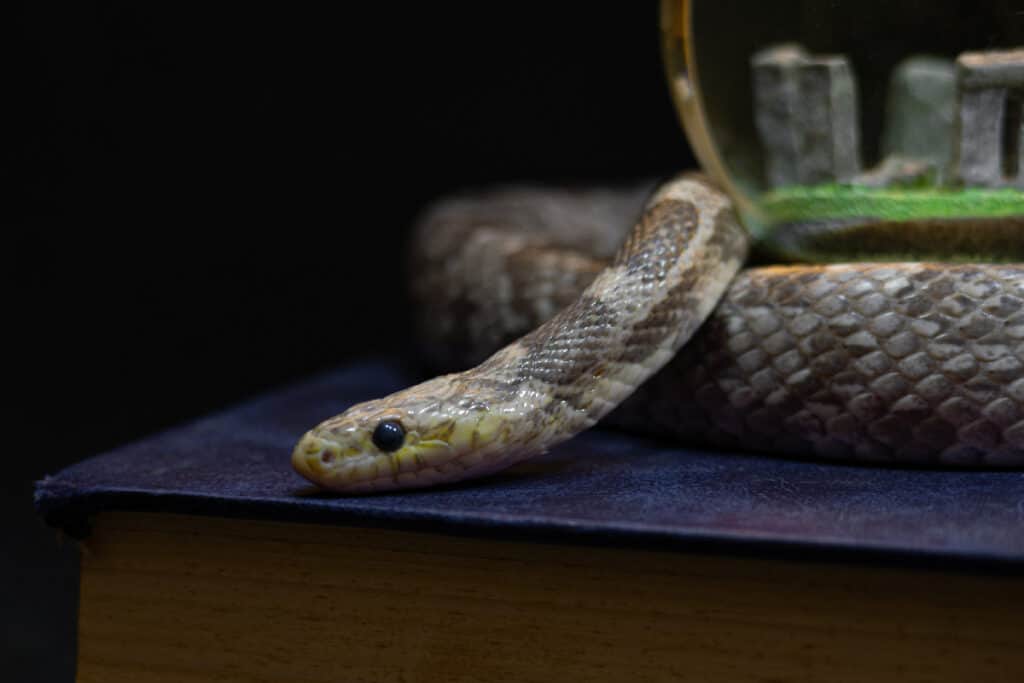
Anerythristic morphs are shades of black, white, and grey.
©TKBackyard/Shutterstock.com
There are two types of anerythristic morphs, anery-a, and anery-b. Anerythrism simply means the lack of erythrism within the snake. Erythrism is the red pigment inside of the snake’s scales and skin, and since most corn snakes are naturally red to some extent, this essentially turns the snake shades of black, white, and grey.
Type: Single recessive mutation
Average Cost: $150
Avalanche
The avalanche morph is characterized by red eyes, white bodies, and pink undertones. A distinct pattern is still visible, although it appears washed out and muted. A truly beautiful morph, it also goes by the names diffused snow and bloodred snow.
Type: Amelanistic, Anerythristic, Diffused, Masque
Average Cost: $250
Blizzard
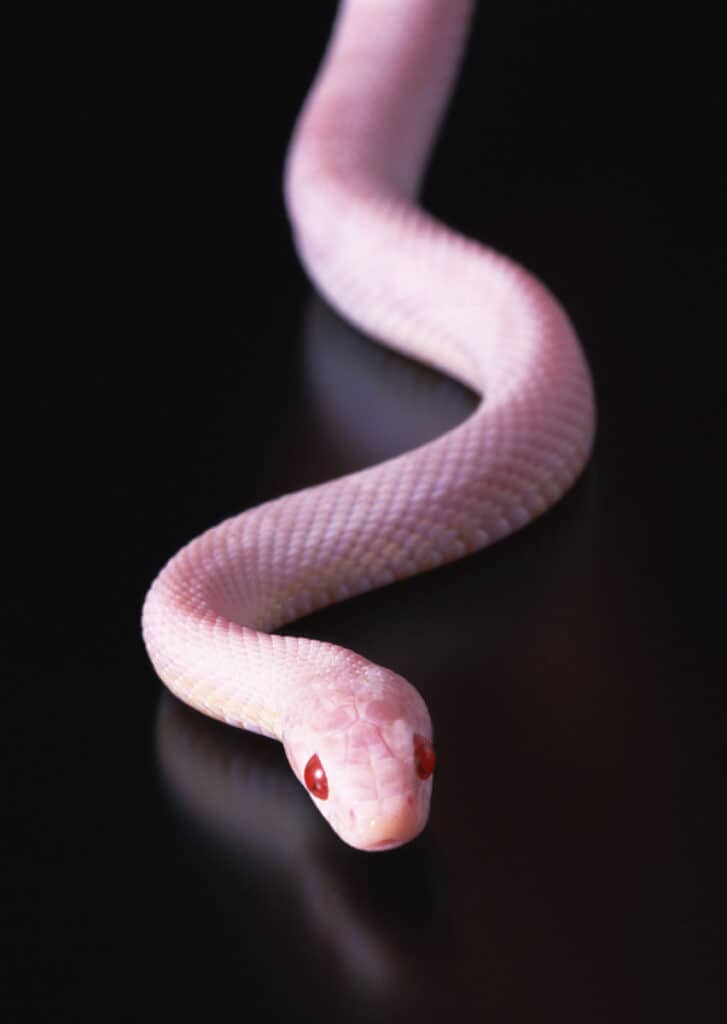
Blizzard corn snake morphs are especially stunning.
©iStock.com/imagenavi
Where the avalanche morph has a clear pattern and pink undertones, the blizzard morph is stark white with pink or red eyes. This shocking coloration is distinct and memorable, perfect for anyone looking for a corn snake that is clearly unique and one-of-a-kind.
Type: Amelanistic, Charcoal, Diffused, Masque
Average Cost: $200-$300
Candycane
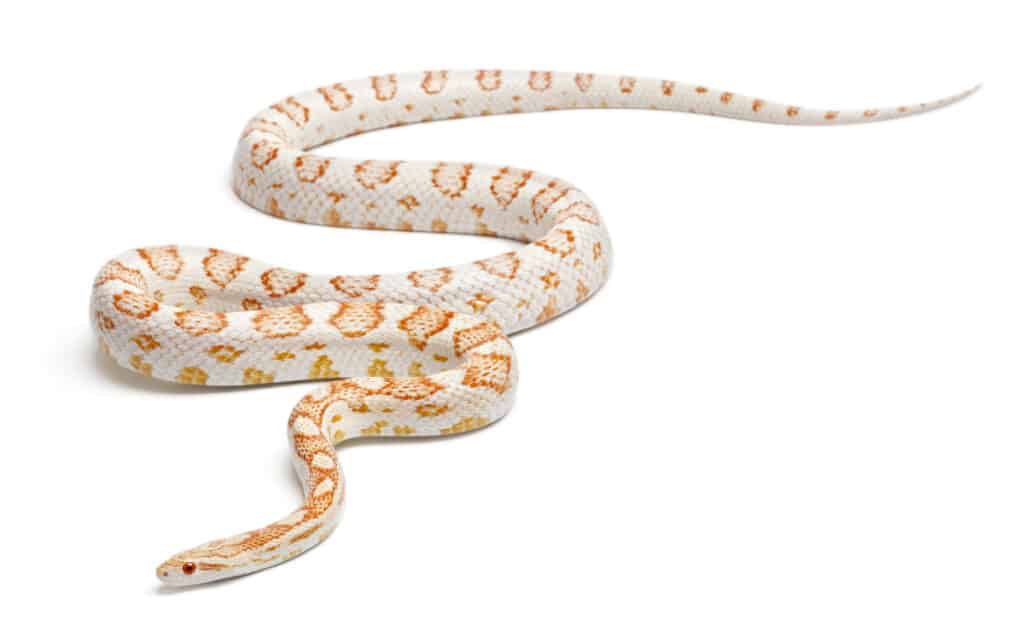
Candycane corn snakes have white bodies and bright red patterns.
©iStock.com/GlobalP
The candycane morph isn’t a hard one to guess! Known for the white bodies with bright red patterns across the snake, you can be sure this snake is eye-popping. Whether it’s Christmas or not, the candycane morph is festive and an incredible-looking snake to behold.
Type: Amelanistic + selective breeding
Average Cost: $70-$100
Charcoal

Charcoal snakes generally lighten as they age.
©iStock.com/Nynke van Holten
The charcoal morph is sometimes referred to as Anery B since it is also an anerythristic mutation. As hatchlings, they are dark grey with distinct patterns. As they age, they generally lighten and become a washed-grey with distinct patterns and black eyes. This noir snake is clearly beautiful in its minimalism.
Type: Single recessive mutation
Average Cost: $200-$300
Cinder
The cinder morph originated in the Upper Keys of Florida and is known for its anerythristic coloration (black, white, and grey) but with a red pigmentation that gives a distinct underdone. The pattern across their back is usually characterized as “jagged”. It can also go by the name “Ashy”.
Type: Single recessive mutation
Average Cost: $150-$200
Opal
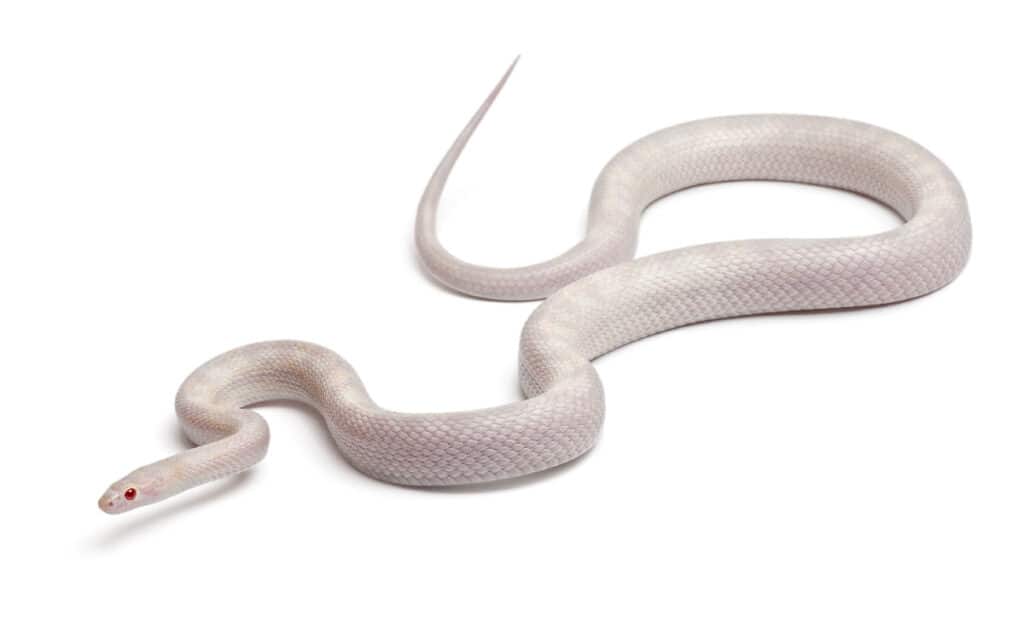
Opal morphs are named for a rare gem.
©iStock.com/GlobalP
The opal morph is known for its patternless white body and red eyes. The distinct red undertone makes this snake appear as if you can see the blood under its skin. Named for the rare gem, this snake is truly a gem itself and worth the price for anyone looking for something unique.
Type: Amel + Lavender
Average Cost: $275-$300
Palmetto
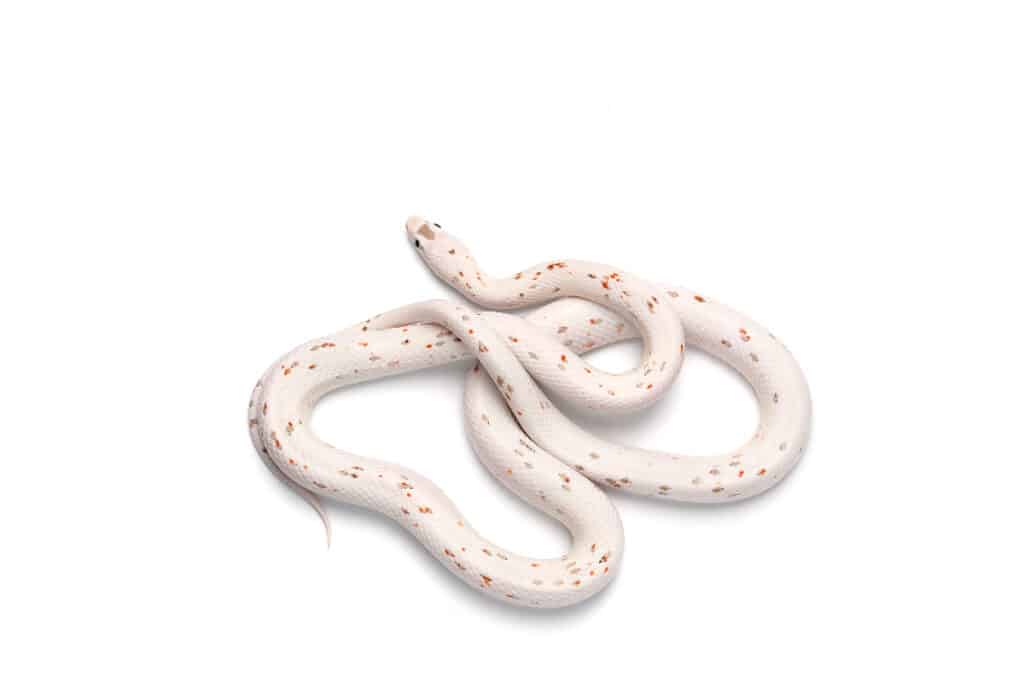
A white body with random specklings characterizes palmetto morphs.
©iStock.com/PetlinDmitry
The palmetto morph may just be the prettiest one on the list. Characterized by its white body with random specklings of coloration in an almost pixel-like pattern. These snakes are so amazing to see that many won’t even believe them to be corn snakes.
The palmetto morph was created by breeding different types of anery, amel, and lavender morphs together until the current palmetto was created as its own incomplete dominant mutation.
Type: Single recessive mutation
Average Cost: $600-$700
Pewter
Named after the metal alloy that shares the same color, pewter morphs are almost solid grey in color, with a faint pattern visible in adults. Some individuals will have black speckles across them and are reffed to as “pepper” pewters.
This unique snake was created by breeding diffused, masque, and charcoal morphs together and is now recognized as its own morph.
Type: Diffused + Masque + Charcoal
Average Cost: $200
Phantom

Hobbyists are increasingly attracted to phantom morphs.
©fivespots/Shutterstock.com
The phantom morph is essentially a ghost morph that has reduced black pigments across its body. Characterized by its white base and grey patterns, the phantom tends to only get paler as it ages. This ghostly snake has earned its name and is worth a look from any hobbyists.
Type: Diffused + Masque + Charcoal
Average Cost: $250
Plasma
The plasma morph is known for its white coloration and almost grey “sheen” across its body. The lavender genes give a faint pink coloring to this snake, although it initially appears monochromatic.
Type: Diffuse + Lavender
Average Cost: $650
Tessera – Anerythristic
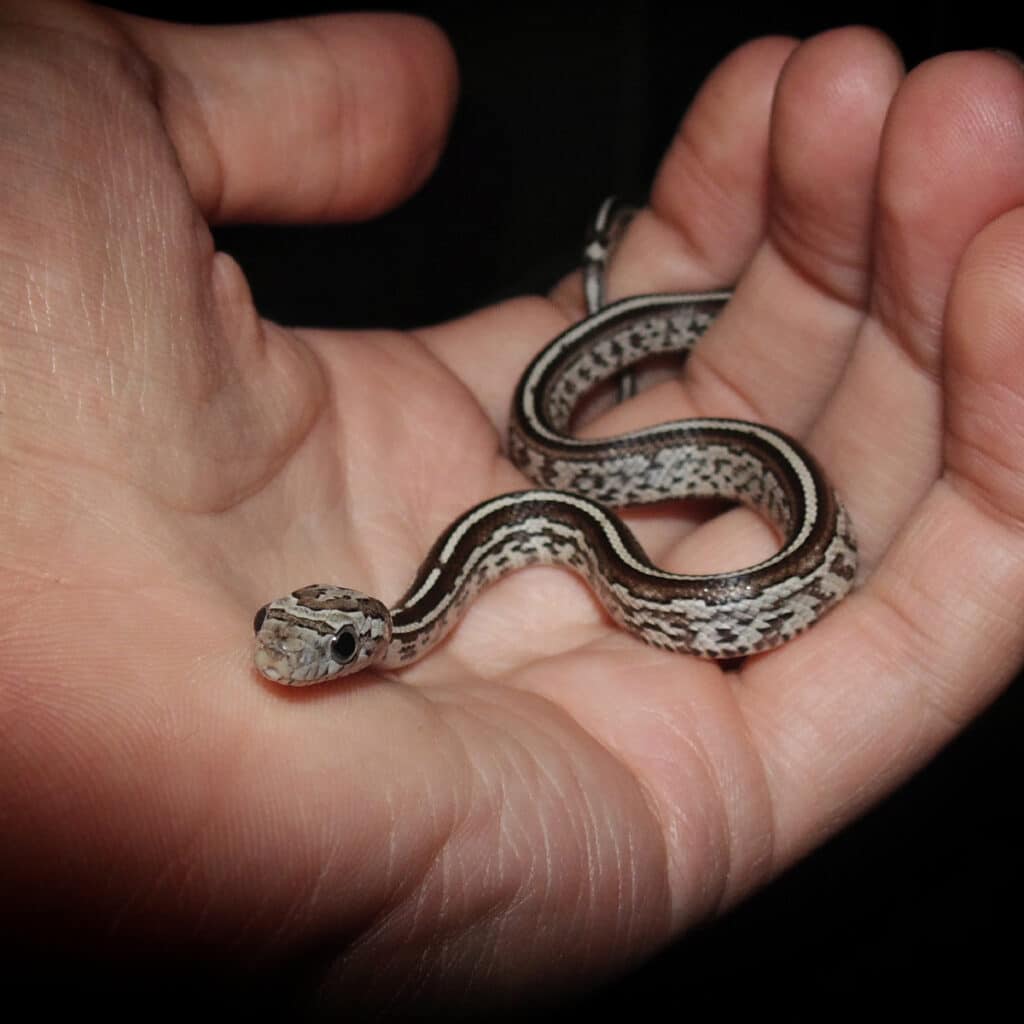
If you’re seeing a morph that resembles pixelated geometry, it’s likely a tessera morph.
©PauloPadrao/Shutterstock.com
The tessera morph refers to the specific pattern on the snake, while the anerythristic denotation refers to the color. Tessera snakes are characterized by thin, strong dorsal stripes that go from tip to tail. Additionally, they have side patterns that resemble pixelated geometry. This pattern, combined with the anery morph, gives us a truly striking and unique black and white snake that looks almost nothing like a corn snake. In fact, many people mistake them for strange-looking garter snakes.
Type: Unknown, possibly wild
Average Cost: $100-$200
Red, Orange, and Yellow
If you are looking for a snake with a bit more color to it, corn snakes are a great option. Naturally, corn snakes come in shades of red and yellow. As a result, breeders looking to accentuate these traits haven’t had much trouble coming up with some truly fantastic morphs.
Amelanistic
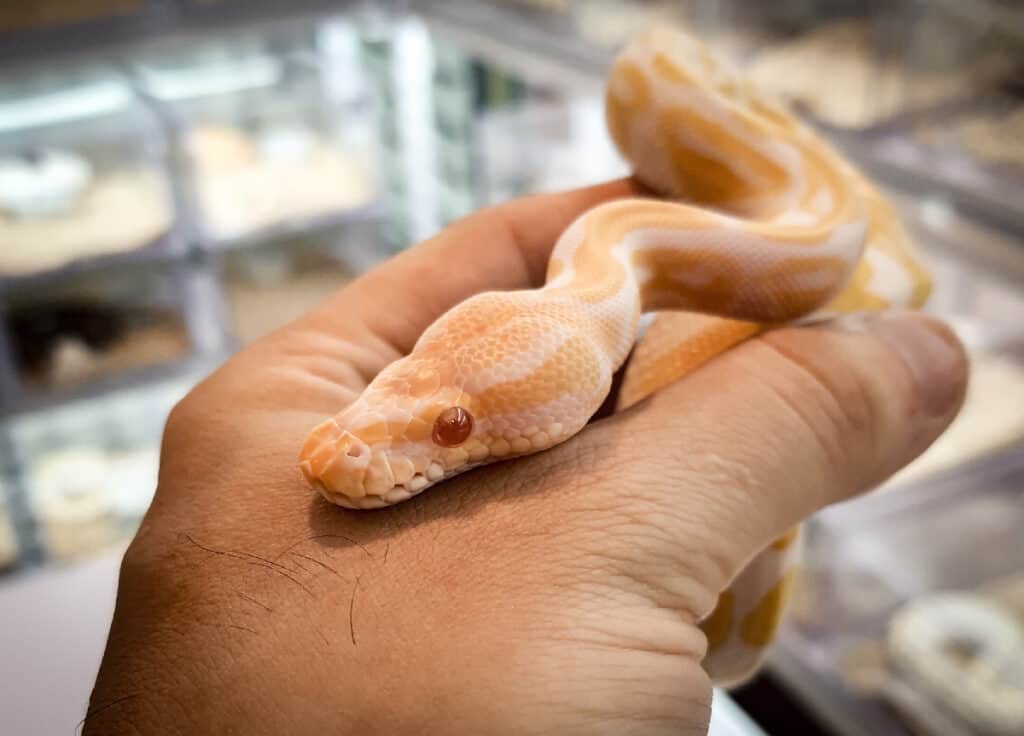
Looking for a snake with light colors? An amelanistic morph could be right!
©Jirat Sarmkasat/Shutterstock.com
Amelanism refers to a lack of melanin, and the amelanistic morph is just that. Without the dark pigmentation that comes with melanin, these snakes are known for their light colors, usually with some shade of pink or white present. Amelanistic morphs are used as the base for many other morph combinations and are thus present in many of the following options to some capacity.
An additional note, however, is the distinction between albinism and amelanism. Albinism is the total lack of melanin, while amelanism refers to less melanin with deposits only in certain locations.
Type: Single recessive mutation
Average Cost: $100
Bloodred
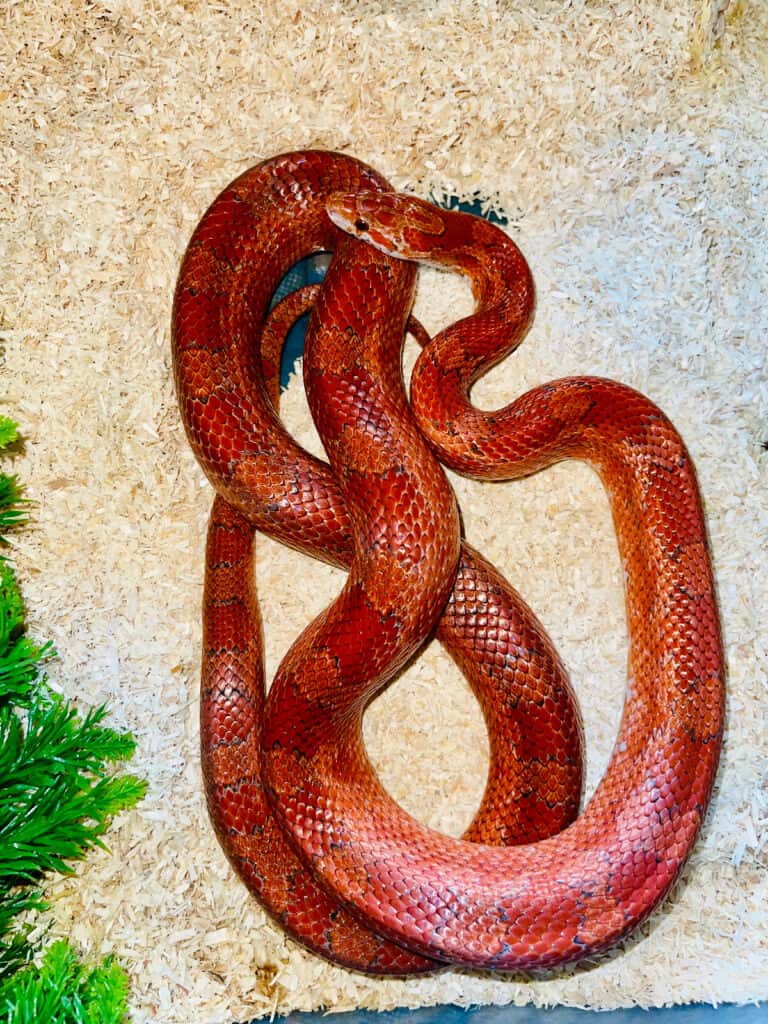
Bloodred morphs live up to their name.
©Reptile_Stacey/Shutterstock.com
The bloodred morph is one of the most striking of all corn snake morphs. Characterized by their blood-red color and rich pigmentation, the bloodred morph appears to be a fictional snake (but it isn’t). Some bloodred morphs are simply red in color with traditional patterns, while some, much more rare individuals, are totally red.
There is a bit of contention surrounding bloodred morphs and diffuse morphs, mostly around the genetic occurrence and if they are the same thing (it can get really nerdy). Still, we decided to include both even though many would choose to categorize them together, with the bloodred morph as simply a line from the diffuse morph.
Type: Diffused + Masque
Average Cost: $20
Bloodred Pied Sided
The bloodred pied-sided is an example of a corn snake morph with the piebald genetic mutation. The resulting snake is red on the top with little to no patterns, with large white patches across the belly. This mutation is unique, and combining the bloodred morph with the pied-sided morph creates something spectacular.
Type: Diffuse
Average Cost: $250-300
Butter

If you’re looking for cream and butter colors, then a butter morph will work!
©iStock.com/GlobalP
As you can imagine, the butter morph is characterized by a cream and butter coloration with distinct patterns across the back. The coloration is caused by the amelanistic morph and caramel morph, creating a snake that almost looks like an albino python that we all saw growing up.
Type: Amelanistic + Caramel
Average Cost: $100-$200
Caramel

Caramel morphs develop stronger yellow pigmentation as they age.
©Scink/Shutterstock.com
The caramel morph is a single mutation that is characterized by its caramel color and distinct pattern. The original mutation came from wild specimens that were captured and bred extensively. As they age, many caramel morphs develop stronger and more yellow pigmentation across their bodies. As hatchlings, they can have almost no yellow pigmentation at all.
Type: Single recessive mutation
Average Cost: $100-$200
Creamsicle
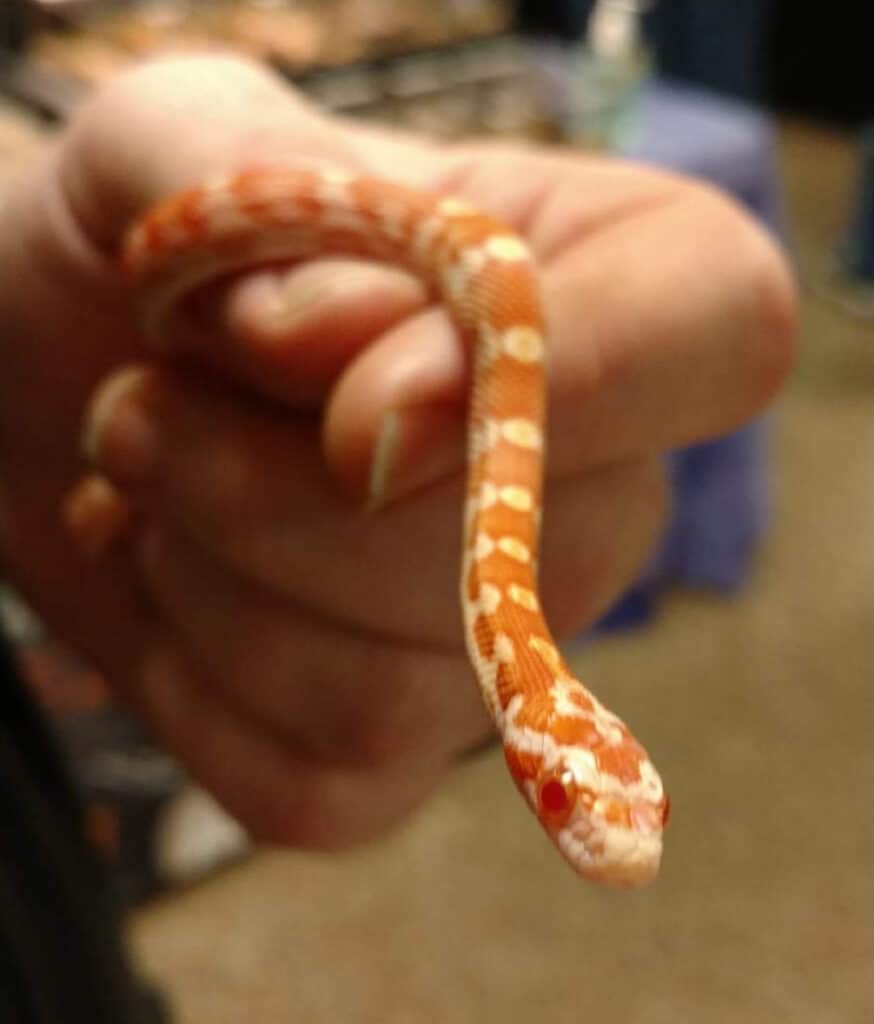
First bred in France, creamsicle morphs became incredibly popular.
©iStock.com/Desiree Shepherd
The creamsicle morph may be one of the most interesting morph stories on our list. The original creamsicles corns were first bred in France and are a cross between Amel corn snake morphs and Emory’s ratsnake. The resulting hybrid isn’t a full corn snake, but they are so prevalent that many breeders don’t even know that they are a cross between species.
Type: Amel Cornsnakes + Emory’s Ratsnake
Average Cost: $100
Diffused
The diffused morph is often confused with the bloodred morph, primarily because the attempts at breeding bloodreds resulted in the recognition that bloodred mutation was a secondary effect of a different mutation, known as the diffused morph. For most people, the diffuse morph usually means a bloodred corn snake with a light belly and diffused pattern on their back, although different people may call it something else.
Type: Single Recessive Mutation
Average Cost: $100-$200
Fire-Cayenne
The fire-cayenne morph is characterized by its incredibly bright and vibrant red coloration, highlighted with white between the scales. The fire-cayenne is actually just a variant of the fire morph, however, and is sometimes referred to as an albino bloodred.
The amelanistic morph plus the red factor of the diffuse morph create these striking snakes.
Type: Amelanistic + Diffuse
Average Cost: $150-$300 (unable to find cayenne-specific pricing)
Honey

Honey morphs are lighter than many other varieties.
©iStock.com/capri92x
The honey morph is characterized by its golden yellow coloration and strong patches of yellow lined with black. Generally lighter than the amber morph, the honey morph is a beautiful snake that is worthy of display.
Type: Single Recessive Mutation
Average Cost: $99
Hypomelanistic

If you’re looking for darker snakes, you should consider a hypomelanism morph.
©iStock.com/Svetlanistaya
Where amelanism is the reduction of melanin, hypomelanism takes it to the extreme. Hypomelanistic snakes appear like traditional corn snakes; only there is dark red or white where black pigment usually is. They often are light red snakes with maroon patches across their back.
The strawberry morph and Christmas morph have recently been found to be genetically similar to hypomelanism and are sometimes classified as a subsection of it.
Type: Single Recessive Mutation
Average Cost: $75-$100
Lava
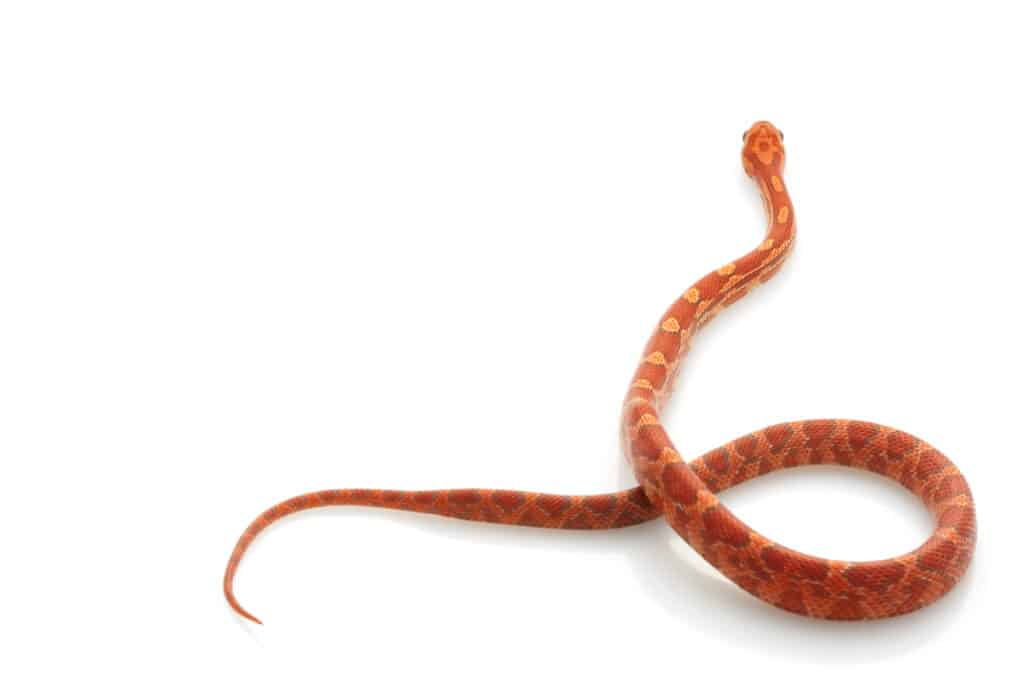
Lava morphs are typically lighter in color than similar morphs.
©fivespots/Shutterstock.com
The lava morph is sort of a hypomelanistic strain, only with a stronger effect on the black pigmentation than most others. The main difference between the two is that most lavas usually have some type of grey lining around some of the patches and in the lighter areas.
Type: Single Recessive Mutation
Average Cost: $200
Motley
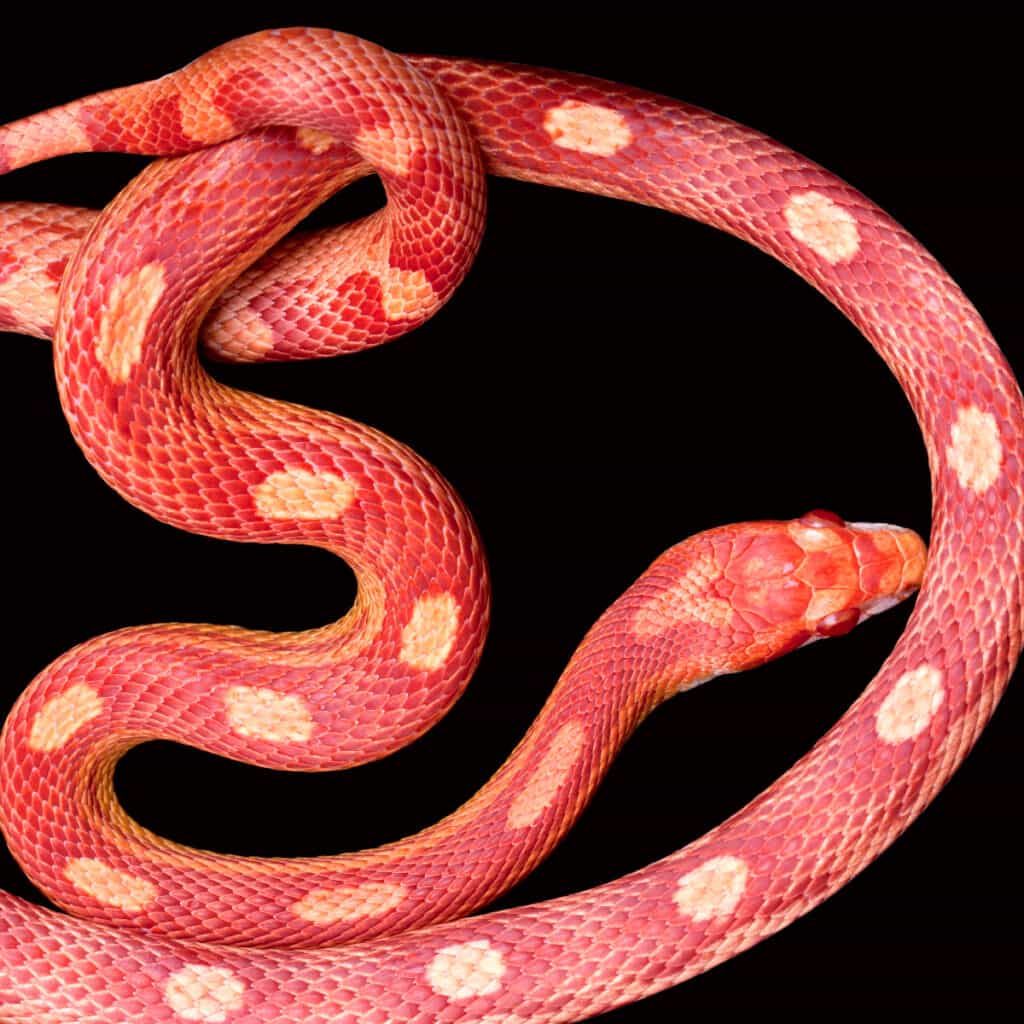
Motley
snakes live
up to their name and are highly irregular.
©iStock.com/imarly
The motley morph is actually a pattern morph, not a color one. As a result, the actual appearance of the snake will depend on the color morph that it has been bred with. Motley patterns are characterized by a total lack of belly patterning, a dark line on the ventral scales, and faint blotches that are spaced irregularly. This pattern is incredibly variable, however, hence the “motley” in its name.
Type: Single Recessive Mutation
Average Cost: Varies with color morph but can go for as little as $75
Okeetee
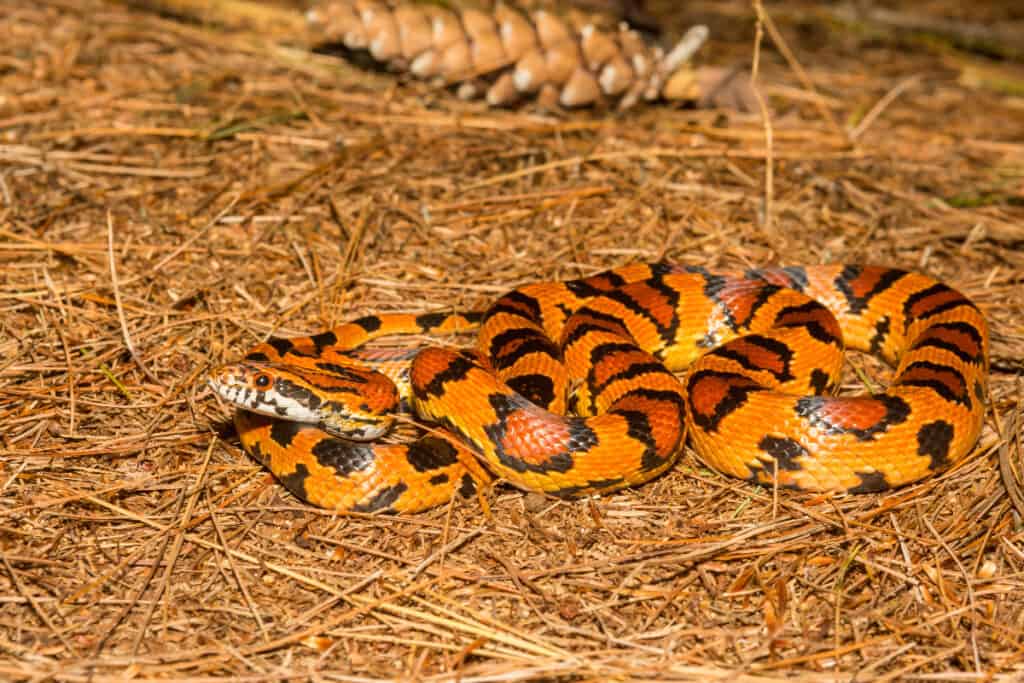
There are many variation of the Oketee morph, including the scaleless Oketee.
©Jay Ondreicka/Shutterstock.com
The Okeetee morph is known for its red coloration and deep red blotches ringed in black. Their bellies are usually white or cream. The Okeetee morph is a wild subspecies of corn snakes that were first found in South Carolina and have been selectively bred since. There are many different variations that have descended from the Okeetee morph, notably, the scaleless Okeetee morph.
Type: Wild-type
Average Cost: $100-$200, depending on type. Can be as much as $500 for scaleless morphs.
Sunglow
The sunglow motley is characterized by its light orange shading and dark orange blotches on its back. They generally have white bellies, and their look resembles the glowing sun as it rises or sets. The morph is often marketed well but is just a cornsnake with motley, hypomelanistic, and amelanistic traits.
Type: Motley + Hypo + Amel
Average Cost: $100, but doesn’t always go by that name.
Sunkissed
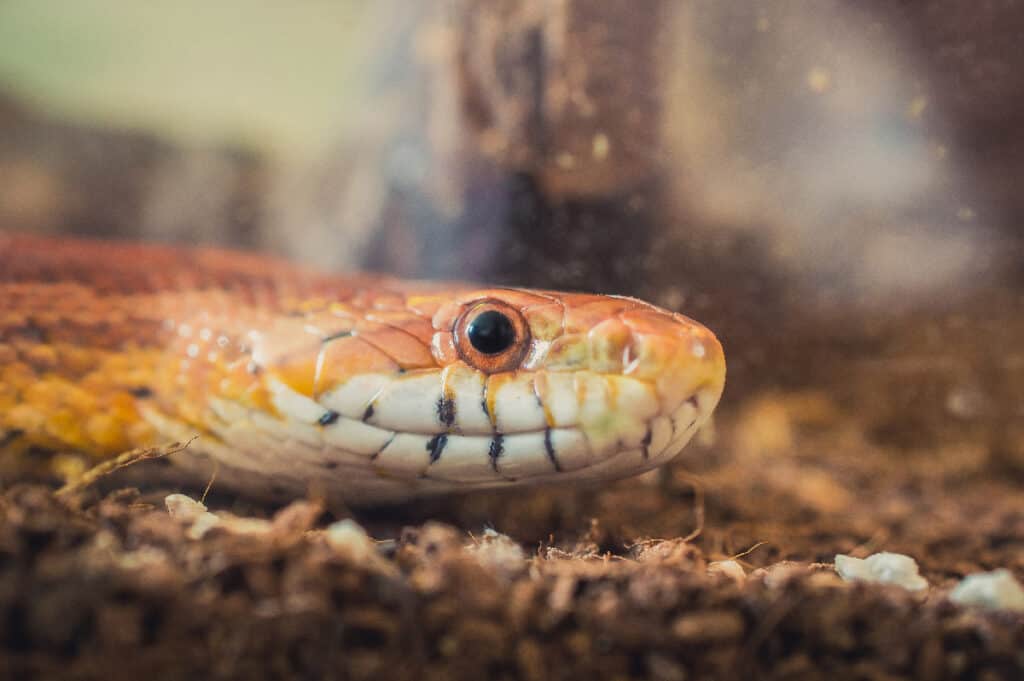
Sunkissed morphs are lighter than traditional
hyopmelanistics.
©iStock.com/Tamascsere
The sunkissed morph is almost identical to the hypomelanistic morph; only it originated from the specific breeding lines of Kathy Love. They are occasionally known fo have a slightly lighter appearance than traditional hyopmelanistics.
Type: Single Recessive Mutation
Average Cost: $100-$200
Pink and Purple
Pink and purple snakes are generally rare, despite the over 3,000 species of snake that exist in the world. With a lot of dedication and specialized breeding, however, there are some truly remarkable examples of pink and purple snakes just with the corn snake species. Let’s take a look at some of these examples now.
Lavender
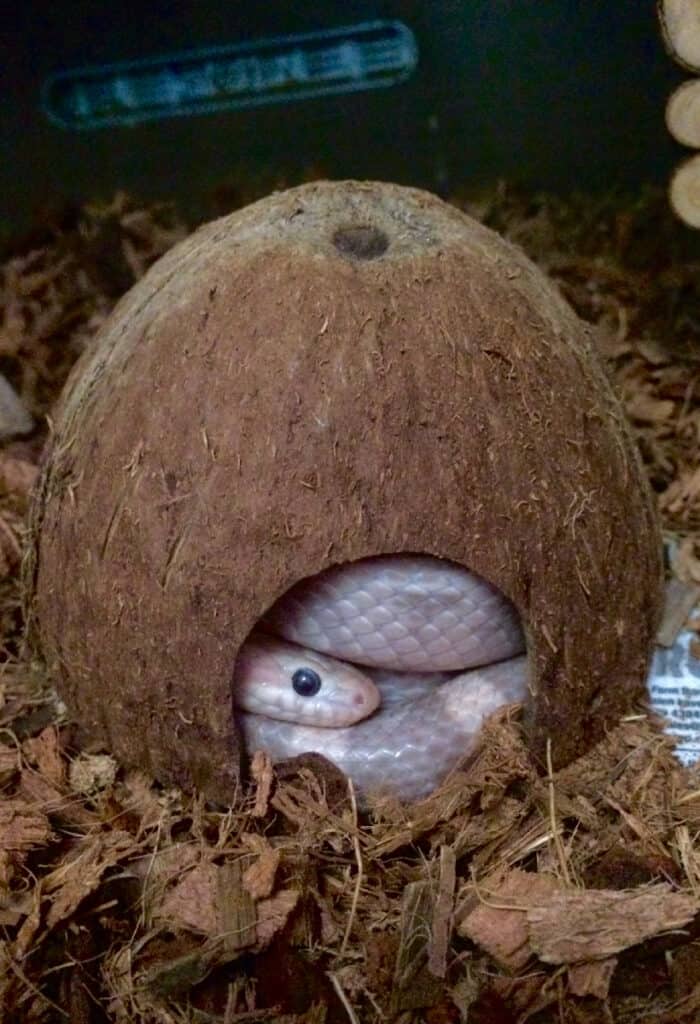
Lavender morphs are mysterious.
©Andy Harvie/Shutterstock.com
The lavender morph is one of the most mysterious morphs around, mostly because people don’t know what causes it. The current guess is that it is a tyrosinase-positive form of albinism that results in a light purple color that is astoundingly beautiful. Combining this trait with other morphs is usually the base for most purple or pink-colored cornsnakes.
Type: Single Recessive Mutation
Average Cost: $200-$300
Lavender Ghost
The lavender ghost is the marketing name for a very pale anerythristic morph mixed with a lavender morph. Where straight lavender morphs have black or grey markings, lavender ghosts are much paler and whiter.
Type: Lavender + Anerthrystic
Average Cost: $200
Moonstone
The moonstone morph is another example of an anerythristic and lavender cornsnake. The main variations with this morph are the tan blotches and purple-brown eyes. This is a difficult snake to find, so beware of breeders claiming to sell “moonstone” morphs, especially since it is more of a marketing term.
Type: Lavender + Anerythristic
Average Cost: Unable to find online sale
Coral/Salmon Snow

You know nothing, salmon snow.
©iStock.com/mynewturtle
Both coral and salmon snow morphs are characterized by their white bodies with diffused ink spots and colorations across their bodies. Essentially, both morphs are amelanistic and anerythristic morphs with an added red factor (found in the diffused morph). The red factor creates the subtle pink tones that one might see in salmon or coral.
Type: Amelanistic + Anerthrystic + Red Factor
Average Cost: $180-$250
Normal Morphs
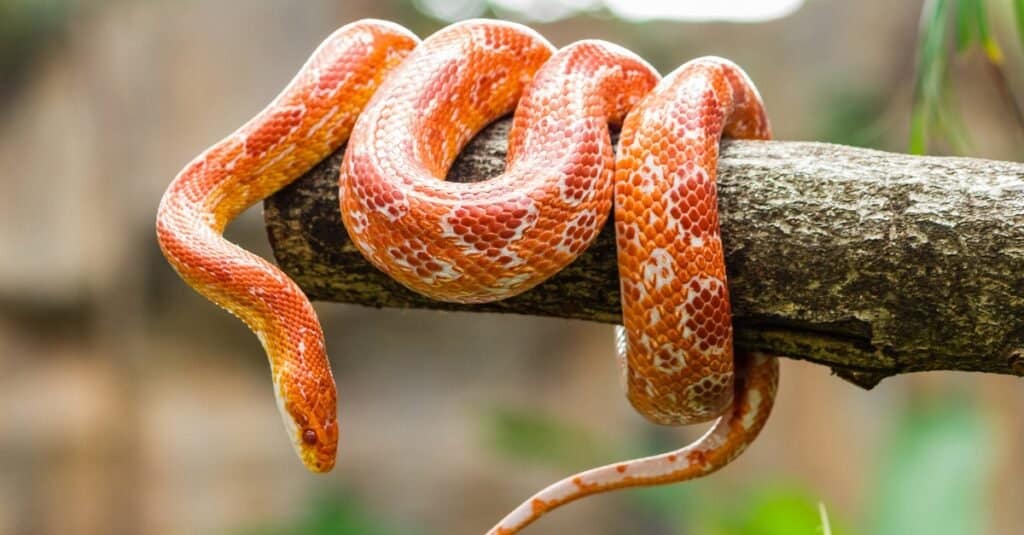
Normal corn snakes can be just as beautiful as “designer” morph ones.
©iStock.com/bugphai
While we covered quite a few morphs, we didn’t cover all of them! One of the major groups of corn snakes that potential owners look into are the standard or “normal” morphs. These are simply corn snakes that haven’t been selectively bred for certain colorations or traits and look similar to how you would find them in the wild.
The great thing about normal morphs? They are cheap! Most pet stores carry normal corn snakes for as little as $30, so if you are just getting started on your journey, that is a great place to start.
The photo featured at the top of this post is © iStock.com/imarly
Discover the "Monster" Snake 5X Bigger than an Anaconda
Every day A-Z Animals sends out some of the most incredible facts in the world from our free newsletter. Want to discover the 10 most beautiful snakes in the world, a "snake island" where you're never more than 3 feet from danger, or a "monster" snake 5X larger than an anaconda? Then sign up right now and you'll start receiving our daily newsletter absolutely free.
Thank you for reading! Have some feedback for us? Contact the AZ Animals editorial team.






